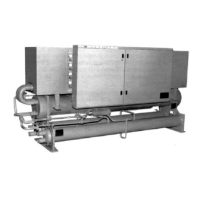Product Manual WHR-2 9
Temperature Control
The McQuay WHR-040EW through 210EW water chillers are available with any one of three
different temperature controls to satisfy your requirements: 1) the standard microprocessor leaving
water controller, 1a) the same controller but with an indicator light package, and 2) the MicroTech
Controller.
Standard Control
WHR-017 - 030
A return water electromechanical temperature controller is supplied on the WHR-17 through 030
when supplied with two stages. Three stage units are supplied with a solid state, return water
temperature controller.
On Model EA units for remote condensers this controller is equipped with terminals from which the
first fan motor can be energized on compressor start. These sizes have a single refrigerant circuit.
WHR 040 - 210
The UNT-33 microprocessor leaving water temperature controller is standard on all units from size
040 to 210 and provides precise temperature control based on leaving water temperature. The
control is preset and calibrated and no other adjustment is required other than setpoint. There is a
60 second interstage On Delay between stages. Each stage incorporates minimum on and off timers
with a maximum cycle rate of six cycles per hour. Reset of supply water temperature can be
accomplished from outside air temperature, zone temperature or a signal from an EMS system.
Condenser fan control (Model EA)
Some means of controlling discharge pressure is required on condensers applied to the WHR-EA
remote condenser units. The McQuay AC/AQ air-cooled condensers can be equipped with
pressure activated fan cycling switches or with variable speed drives. Neither method requires
interconnecting wiring between the chiller and condenser.
Optional Control
Optional Zone Terminal for use with the UNT Control
Provides for onboard (or remotely wired) monitoring or adjusting of certain functions.
• Monitoring
• Monitor up to three setting or sensed values
• Monitor 18 different on/off inputs
• Monitor alarm status via a flashing alarm light and flashing symbol
• Adjusting, allows adjustment of any flashing set points, three at a time, typically set up so that
the relationship between values can be viewed simultaneously. For example:
• Display 1 = Lvg Water temp
• Display 2 = Lvg Water SP
• Display 3 = % Unit Load

